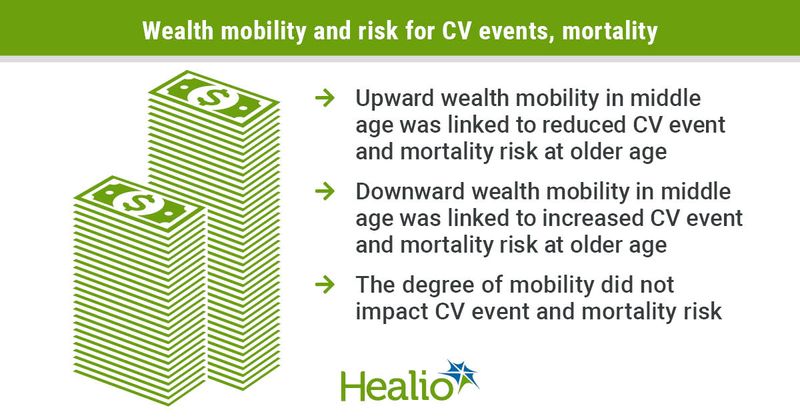Upward midlife wealth mobility may lower risk for CV events, death
Adults with upward wealth mobility in late middle age had reduced risk for CV events or death after age 65 years, researchers reported in JAMA Cardiology.

“Low wealth is a risk factor that can dynamically change over a person’s life and can influence a person’s cardiovascular health status,” Muthiah Vaduganathan, MD, MPH, cardiologist at Brigham and Women’s Hospital, said in a press release. “So, it’s a window of opportunity we have for an at-risk population. Buffering large changes in wealth should be an important focus for health policy moving ahead.”

Wealth and CV risk
Sara Machado, PhD, fellow in the department of health policy at the London School of Economics, and colleagues analyzed RAND Health and Retirement Study data from 5,579 patients (55% women; 76% white) without underlying CVD, stroke, hypertension or diabetes aged 50 to 64 years who were interviewed in at least two of three age ranges (50 to 54, 55 to 59 and 60 to 64 years) and had follow-up data after age 65 years.
Wealth at the time of survey was categorized into quintiles and included all nonhousing assets, expressed in 2012 U.S. dollars. The relative change in wealth between the first and last survey responses constituted wealth mobility, with upward and downward mobility considered an increase or decrease of at least one quintile, respectively; no change in quintile was considered stable wealth. Wealth was stratified by birth cohort to minimize the impact of temporal economic changes or advances in preventive medicine. Mean follow-up was 16.9 years.
CV events or death occurred in 24% of participants during follow-up from age 65 to 85 years, with rates of 14.4 per 1,000 person-years in the overall cohort, 15.3 per 1,000 person-years for those starting in the bottom quintile and 13 per 1,000 person-years for those starting in the top quintile. Participants ending in the top quintile had 12.3 CV events or deaths per 1,000 person-years, whereas those ending in the bottom quintile had 17.6 events or deaths per 1,000 person-years.
After adjustment, higher initial wealth was associated with reduced risk for CV events or death (adjusted HR per quintile = 0.89; 95% CI, 0.84-0.95; P = .001), the researchers wrote.
Downward mobility poses risk
CV events or death occurred more frequently in participants with downward mobility (28.1%) than in participants with upward wealth mobility (22.5%; aHR for upward vs. stable mobility = 0.84; 95% CI, 0.73-0.97; P = .02; aHR for downward vs. stable mobility = 1.15; 95% CI, 1-1.32; P = .046). Upward and downward mobility of more than one quintile was not associated with a statistically significant increase or decrease in CV events or death compared with one quintile change.
“These findings suggest that wealth mobility may offset some of the cardiovascular risk associated with past economic hardship,” Machado and colleagues wrote. “Further work is necessary to examine this wealth-health association in more diverse populations, elucidate mechanisms for these observations and identify potential policy interventions to facilitate wealth mobility among low-income adults.”
